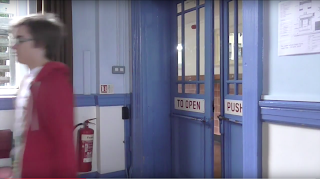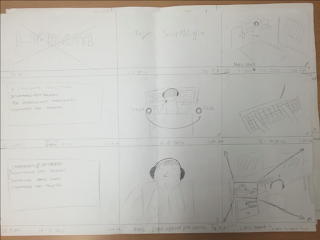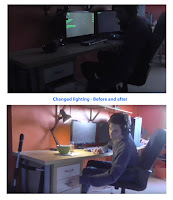7. Looking back at your preliminary task, what do you feel you have learnt in the progression from it to the full production?
Looking back at the preliminary task, it could have been edited better. I should have shown the main character walking across the room and sitting down:


I realise this now because of the filming and editing that I did with my opening scene. During the creation of the opening scene, we had encountered problems with continuity and match on action with the first edit. After some re-filming and additional edits, we managed to overcome the continuity problems and make sure the the match on action parts were as accurate as possible. I have also learnt how to do a more detailed storyboard as the storyboard that I did with the preliminary task was limited in the amount of information with the story and camera angles. With the opening scene, I did a more in-depth storyboard showing the narrative, camera angles, the sound and the duration of the individual shots.


I realise this now because of the filming and editing that I did with my opening scene. During the creation of the opening scene, we had encountered problems with continuity and match on action with the first edit. After some re-filming and additional edits, we managed to overcome the continuity problems and make sure the the match on action parts were as accurate as possible. I have also learnt how to do a more detailed storyboard as the storyboard that I did with the preliminary task was limited in the amount of information with the story and camera angles. With the opening scene, I did a more in-depth storyboard showing the narrative, camera angles, the sound and the duration of the individual shots.
The preliminary task taught me a lot about making a short film. Before doing this task, I had no prior knowledge or experience of filming anything. This meant that I made a few mistakes which I have listed above. I then learnt from those mistakes and I think that it shows in my final media product as it has been created to a higher standard than that of the preliminary task.

After we had made our short films for task eleven, we chose our groups that we were going to be working with for the next few months and sat down to create an opening scene to a Coming-of-Age film. Our storyboard worked because it presented our vision of what we wanted the opening scene to look like but was detailed enough to know what camera angles were being used in each take and how long for. This is a vast improvement over the preliminary task's storyboard as that just had drawings about what the end result would look like. It had no detail of sound (except a short script), how long each scene was or what type of camera angles that was going to be in the short film.
We then had to work out what our target audience for our film was going to be. Given that all three of us were males, we decided to go down the route of the male teenager demographic and knowing it really helped us decide what kind of a narrative that we wanted to show. This was overlooked in the preliminary task. However, the short film of the preliminary task featured an all-male cast so it was assumed that the target audience would be males.
We also researched the kinds of sound and typography that we needed to use. This was not researched for the preliminary task. I learnt that the sound and typography had to connect with the target audience but also connect with the character and the narrative. These elements are key to any opening scene or short story as they are designed to hook in the viewer and get them intrigued into the rest of the narrative. It also gives the audience an immediate representation of the genre and seriousness of the films.
 During the editing of the first take, we realised that the lighting was way too low. For future shoots, we had to change the lighting to make the entire scene visible. The reason why we shot the first edit in the lighting that we did was because the preliminary task had perfect lighting so we didn't have to re-shoot or change the lighting at all.
During the editing of the first take, we realised that the lighting was way too low. For future shoots, we had to change the lighting to make the entire scene visible. The reason why we shot the first edit in the lighting that we did was because the preliminary task had perfect lighting so we didn't have to re-shoot or change the lighting at all.
 During the editing of the first take, we realised that the lighting was way too low. For future shoots, we had to change the lighting to make the entire scene visible. The reason why we shot the first edit in the lighting that we did was because the preliminary task had perfect lighting so we didn't have to re-shoot or change the lighting at all.
During the editing of the first take, we realised that the lighting was way too low. For future shoots, we had to change the lighting to make the entire scene visible. The reason why we shot the first edit in the lighting that we did was because the preliminary task had perfect lighting so we didn't have to re-shoot or change the lighting at all.Overall, I have learnt much from this course as a whole but especially the progression from my preliminary task and the final edit of Firewall. These lessons will likely guide me in later jobs that I am aspiring to be in as it can relate to any new product or story narrative.

No comments:
Post a Comment